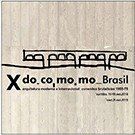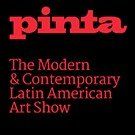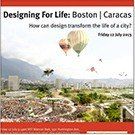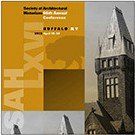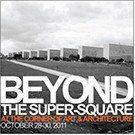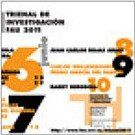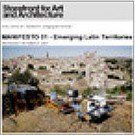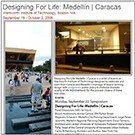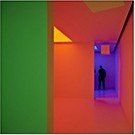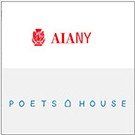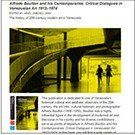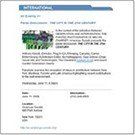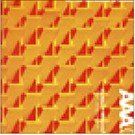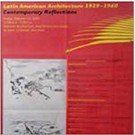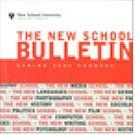Walk-In Wednesday
Lectures/Symposia
Lectures/
Symposia
Upcoming Lectures and Symposia
Curitiba, Oct/15-18/2013
“MODERN AND INTERNATIONAL: Brutalist Connections 1955-75”
In architecture, the 1960’s decade exceeds its temporal limits; and today, it is more alive than ever. And so is Modernism - although it has been transformed, along the last hundred years, from avant-garde to tradition. Besides, when critically considered, several of the current architectural and urban professional practices can have their roots traced back to the heritage and legacy of the optimistic, progressive and fertile years 1955-75.
The extended 1960s decade is a rich period of significant events, works, trends and debates. The X DOCOMOMO SEMINAR BRASIL 2013 wants to be an appropriate opportunity to explore, without depleting, some of that decade’s themes. It proposes a more focused approach on the Brutalism, and welcomes the possibility of opening-up as many paths as possible to approach this subject. It aspires to stimulate and inspire a plurality of contributions, aiming into a comprehensive and varied participation and debates.
Selected Lectures and Symposia
Universided Torcuato Di Tella Escuela de Arquitectura y Estudios Urbanos
Friday August 23, 2013, 7pm
Aula A110. Campus Alcorta: Av. Figueroa Alcorta 7350, Ciudad de Buenos Aires
"Sembrar el Petróleo: Urbanismo Brutalista - Ciudad Guayana, Venezuela 1951-2012"
Wentworth Institute of Technology
Friday July 12, 2013, 9-4pm
WIT Watson Hall, 550 Huntington Ave. Boston
"Towards a Critical History of Caracas: 1497-2013"
Symposium: “Designing For Life: Boston | Caracas”
What do the ongoing design transformations of Boston and Caracas have to learn from each other? How might these insights inform the design and implementation of Caracas’ La Carlota Park or the renewal of Boston’s rich cultural landscapes?
Society of Architectural Historians
Buffalo, NY, April 10-14 2013
“SOWING THE OIL: A NEW CITY IS RISING -- CIUDAD GUYANA, VENEZUELA, 1951-2002”
Political, cultural and economic networks between the United States and Latin America from 1940-1990 stimulated the construction of large scale projects that were a testing ground for new urban and developmental theories. As a consequence of FDR’s “Good Neighbor Policy” to counter the Axis influence throughout Latin America, Town Planning Associates were hired in Brazil in 1944 to design Ciudad dos Motores ,a city dedicated to manufacturing tractors and airplanes. New principles of “Urban Design”, the concept of an urban core, were applied in 1951 by Sert and Weiner working with the young Venezuelan architects Moises Benacerraf and Carlos Guinand to design two new industrial towns Puerto Ordaz and Ciudad Piar for the Orinoco Mining Company (US Steel).
In 1961, a larger scale of investment by Corporacion Venezolana de Guayana, modeled after the Tennesse Valley Authority, founded the new city of Ciudad Guayana and hired The Joint Center for Urban Studies of MIT and Harvard to work on a regional plan that absorbed both Sert’s Puerto Ordaz and the original colonial settlement of San Felix to form a new industrial city parallel to the Orinoco River. Like Buffalo, the new city of “Ciudad Guayana” on the Lower Orinoco valley of Venezuela combined river transportation with abundant hydroelectric power for basic industries and a “planned” new city for the workers and managers involved in the production of steel and aluminum. This paper will show how three different approaches to city building were applied in a short period of time: First, Sert’s urban core/patio ideas, Second, the Joint Center’s “regional planning” for a linear city twenty miles long and Third, “participatory planning” in the 1990’s. Fifty years after its founding, Ciudad Guayana is a city of the approx.1,300,000 inhabitants still in search of an identity.
The Bronx Museum of the Arts,
NY, October 2011
“BEYOND THE SUPER SQUARE: On the Corner of Art and Architecture”
A three day conference designed to draw attention to an important historical period of modernist architectural production in Latin America and the Caribbean that, 40 years later, continues to resonate among contemporary artists. The conference strived to create a foreground for the Museum’s research team, invited scholars, experts, and professionals to enrich a dialogue not often explored within the United States on the enduring fascination with this architectural tradition. The conference contextualized the impact of modernist architecture throughout these regions through a series of panels and presentations by architects, urban planners and contemporary artists.
Speakers: Barry Bergdoll (MoMA), Serio Bessa (The Bronx Museum of the Arts), Carlos Brillembourg (Carlos Brillembourg Architects), Jose Castillo (Arquitectura 911sc), Felipe Correa (Harvard Graduate School of Design), Ana Maria Duran (Estudio A0), Terence Gower (Artist), Hannia Gomez (Fundacion de la Memoria Urbana), Alejandro Hernandez Galvez (Arquine Magazine), Javier de Jesus (Pontifical Catholic University of Puerto Rico), Jorge Liernur (Torcuato Di Tella University School of Architecture), Jose Lira (University of Sao Paulo), William Morrish (Parsons/The New School), Ligia Nobre (Mackenzie University), Mauro Restiffe (Artist), Eduardo Luis Rodriguez (Arquitectura Cuba), and more.
Universidad de Venezuela Facultad
de Arquitectura y Urbanismo (UCV, FAU),
Caracas, Venezuela, June 6-10, 2011
The triennal of Investigation FAU 2011 proposed to stimulate reflection and debate as a way to tackle the themes inherent in the current epistemologies and focus on the methodology of the “project” as the central concept in the discipline of Architecture and Urbanism.
Opening Conference: Josep Muntanola (Spain); Conference 1: Rosa Vera (Venezuela); Colloquium: Jorge Sarquis (Argentina), Susana Jimenez Correa (Colombia), Azier Calvo (Venezuela), Dyna Guitian (Venezuela), Enrique Larranaga (Venezuela), Jose Rosas Vera (Chile), Josep Muntanola (Spain); Conference 2: Graziano Gasparini (Venezuela); Conference 3: Jorge Sarquis (Argentina); Conference 4: Juan Carlos Rojas Arias (Colombia/France); Conference 5: Susana Jimenes (Colombia); Conference 6: Carlos Brillembourg (Venezuela), “HEART OF THE CITY”; Conference 7: Pedro Garcia del Barrio (Spain); Closing Conference: Barry Bergdoll (United States)
Storefront for Art and Architecture
in collaboration with Instituto Cervantes,
New York, NY, October 2010
The presentations and conversations intend to be a declaration of strategies and visions to speculate, understand or project a new approach towards the construction of our built environment from a Latin-American perspective within a global world. The event took place in two venues and was be moderated by curator Ariadna Cantis in collaboration with Eva Franch.
Speakers: “Urban Territories & Material and Sensorial Qualities”: Leonardo Diaz Borrioli, Pablo Lorenzo Eiroa, Cristina Goberna, Javier Iturralde, Andres Jaque, Joaquim Moreno; “Geopolitical Territories & Environmental Sensibilities”: Francisca Benitez, Carlos Brillembourg, “THE LATIN AMERICAN CITY AS A MANIFESTO FOR ARCHITECTURE”, Jose Castillo, Urtzi Grau, Andres Jaque, Ximena Labra & more.
Wentworth Institute of Technology,
Boston, September 2008
Panel Discussion: “DESIGN FOR LIFE: Medellin/Caracas”
A series of events at Wentworth Institute of Technology designed to celebrate and learn from Caracas and Medellin’s marriage of award-winning design with progressive public policy to mobilize dramatic quality of life improvements for the poorest citizens of these two cities.
Speakers: Alejandro Echeverri, Medellin City Planning Department; Jorge Perez Jaramillo, Medellin Regional Planning Department; Oscar Tenreiro, Architect and Central University of Venezuela Professor; Maria Isabel Pena, Head of the Central University of Venezuela Urban Institute; Carlos Brillembourg, Architect and Author, New York City
Americas Society,
New York, NY, September 2008
“(IN)FORMED BY COLOR” panel with the artist Carlos Cruz-Diez
America’s Society presented Carlos Cruz-Diez’s first solo show in a major United States cultural institution. Focusing on the relationship between color and perception, the exhibition seeked to correct the limited understanding and bisibility of Cruz-Diez, one of Latin America’s Kinetic art masters.
Conversation with the artist: Moderator: Gabriela Rangel (Director, Visual Arts Americas Society); Speakers: Carlos Brillembourg (Architect), Carlos Cruz-Diez (Artist), Estrellita Brodsky (Guest Curator), Tahia Rivero (Curator, Coleccion Mercantil), Isabela Villanueva (Assistant Curator)
Center for Architecture
AIA NY Chapter, September 2008
“FORM AND FUNCTION: The Intersection of Poetry and Architecture”
A full-day symposium on poetry and architecture. “Latin American Confluences: Poetry & Architecture at Mid-Century,” looked historically at South America where 20th century political turmoil was fundamental to both literature and architecture. Carlos Brillembourg, AIA, discussed poetry and the city of Paris, particularly the effect of the 1937 international exposition on poets and architects such as Cesar Vallejo and Carlos Raul Villanueva, who fought against fascism in Spain.
Speakers: A.S. Bessa - Director of Programs, Bronx Museum of the Arts; Carlos Brillembourg, AIA - Principal, Carlos Brillembourg Architects, “CARLOS RAUL VILLANUEVA AND CESAR VALLEJO IN PARIS, 1937” Ruben Gallo; Monica de la Torre; Architexts: Louise Braverman; Annie Finch; Jill Stoner; A Conversation with Architect Lebbeus Woods & Poet Susan Stewart; Between Forms: A Poetry Reading : Marjorie Welish; Moderator: Stephen Motika - Program Coordinator, Poets House; Organizers: Poets House & AIA Center for Architecture.
Museum of Modern Art,
New York, September 2008
“GESAMKUNTSWERK IN CARACAS 1952-53:
CRITICAL DIALOUGUES IN VENEZUELAN ART”
To celebrate the MoMA’s publication ‘Alfredo Boulton and his Contemporaries: Critical Dialogues in Venezuelan Art, 1912-1974, Luis Perez-Oramas, The Estrellita Brodsky Curator of Latin American Art at MoMA, moderated a panel discussion on Venezuelan art and architecture of that time period. Speakers: Hugo Achugar, Carlos Brillembourg , Sofia Vollmer de Maduro, Edward Sullivan
America’s Society,
New York, NY, June 2008
“THE CITY IN THE 21ST CENTURY”
Panel Discussions: The city in the 21st century: Anthony Kiendl, (Diector of Plug In ICA, Winnipeg), Carlos Brillembourg (Architecture Editor of Bomb Magazine), “MELVIN CHARNEY AND POST-MODERN URBANISM”, Saul Ostrow (Chair, Visual Arts, The Cleveland Institute of Art) and Gwendolyn Owens The intersection of art and architecture, and the development and transformation of public spaces and cities: Susan Herrington (University of British Colombia, Dan Graham (Artist), and Yasmeen Siddiqui (curator at Storefront)
University of Technology,
Kingston, Jamaica with MoMA,
February-March 2008
The International Program and the Department of Architecture and Design at The MoMA organized the museum’s first symposium on the modernist architecture of the Caribbean and bordering Latin American countries, in collaboration with the Caribbean School of Architecture at the University of Technology, Kingston, Jamaica. The goal was to encourage scholarly, curatorial and broader educational awareness. Topics covered included regional and international legacies, preservation, environmental sustainability and urban planning, as they related to modernist architectural history and contemporary practice.
The presenters were leading architects and architectural historians from the region, and attendees included their colleagues as well as local and international university students, policy makers, civic leaders and developers from Jamaica, the surrounding Caribbean Islands and the United States. An illustrated volume, co-published by MoMA and Archivos de Arquitectura Antilana (AAA), an architectural journal based in the Dominican Republic, presents the papers from this critical symposium in both English and Spanish, making them accessible to a breader public.
Panel Session 3 Speakers: Moderator - Jorge Otero Pailos, Columbia University, Carlos Brillembourg, Architect, Venezuela, “CARACAS: TOWARDS A NEW CITY 1936-1960,” David Gouverneur, The University of Pennsylvania, Silvia Arrango, National University of Colombia, Colombia, Louise Noelle, National Autonomous University of Mexico
New School University with MoMA,
New York, NY, October 2002,
“LATIN AMERICAN ARCHITECTURE: 1929-1960, CONTEMPORARY REFLECTIONS”
In September 1929, Le Corbusier was invited to lecture in Buenos Aires, Montevideo, and Rio de Janerio. He found a culture ready to apply and transform European Modernism to the needs of a new and vibrant economy, and he himself designed a plan to expand Rio. When he returned to Brazil in 1936 to work with Lucio Costa, Oscar Neimeyer, Alfonso Reidy, and Jorge Moreira, modern architecture had taken throughout Brazil, Argentina, and Uruguay. From 1929 with Calder and Villanueva’s Aula Magna and Niemeyer’s plans for Brasilia. Why did Modernism enjoy this striking triumph (commercially and artistically) in Latin America, and why did this golden age abruptly end after twenty years? Introductory Remarks by Terence Riley, Chief Curator, Department of Architecture and Design, the MoMA and Sondra Fargonis, Director, Vera List Center for Art and Politics.
Speakers: Kenneth Frampton, Columbia University, Jorge Francisco Leimor, Center for Studies of Contemporary Architecture, Torcuato Di Tella University, Buenos Aires, Lauro Cavalcanti, University of Design, Rio de Janiero, Jose Antonio Aldrete-Haas, Aldrete-Haas and Associates Architects, Mexico City, Carlos Brillembourg, Carlos Brillembourg Architects, New York/Caracas, “ARCHITECTURE AND SCUPLTURE: CARLOS RAUL VILLANUEVA AND ALEXANDER CALDER’S AULA MAGNA”
New School University,
New York, NY, May 2001
What separates nature and architecture, the god-made and the human-made? Architecture is one art that confronts this issue directly, and it’s constantly shifting line between what is given by nature and what is made by human endeavor tests the cosmology of any given culture. Perhaps in the 21st century, a new concept of nature, interpreted neither by religion nor by science but by art, will establish a new philosophical framework.This framework would not be ideological but more of a research into the meaning of nature as it is used in architectural production. The discussion focused on the work of Frank Lloyd Wright as well as some more recent architects and artists who are explicitly interested in the reinterpretation of nature.
Keynote address by Diane Agrest, The Cooper Union. Respondents: Stan Allen, Columbia Univ.; Herman Czech, architect; Kenneth Frampton, Columbia Univ.; Otto Graf, Vienna Academy of Fine Arts; Robert Irwin, artist, and Carl Prusha, Vienna Academy of Fine Arts. Carlos Brillembourg, architect and moderator.

